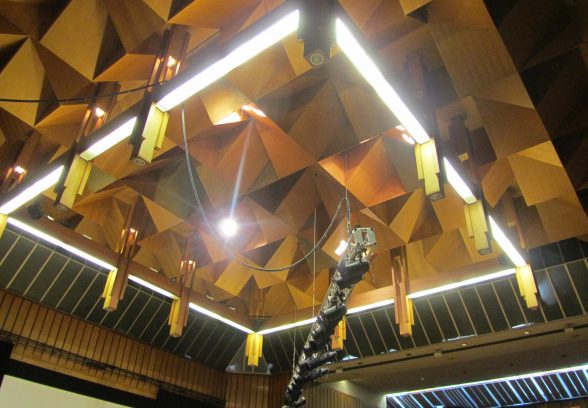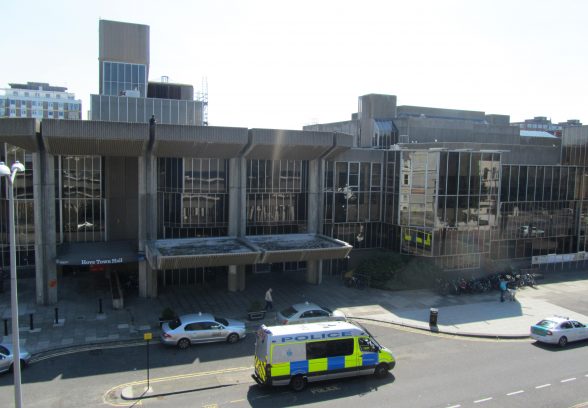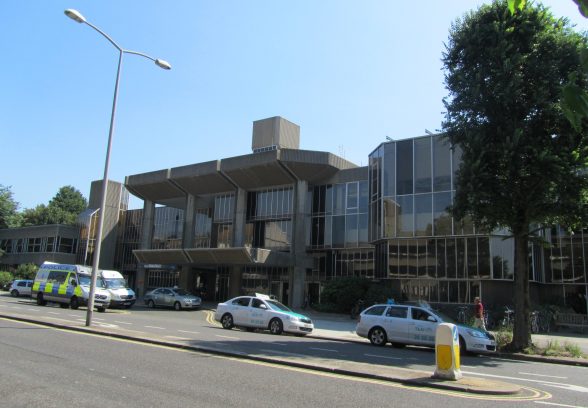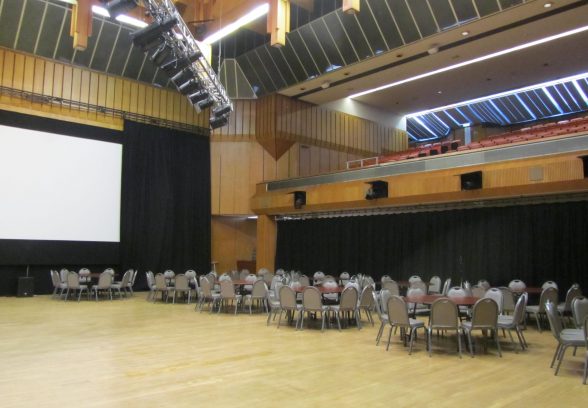This website uses cookies
This website uses cookies to enable it to function properly and to analyse how the website is used. Please click 'Close' to accept and continue using the website.






September 2014 - Hove Town Hall
by Susannah Charlton
Hove Town Hall, built in 1970-3 to the designs of John Wells-Thorpe, is a remarkable example of 1970s Brutalist architecture, replacing the Gothic town hall on the site by Waterhouse (1882, destroyed by fire in 1966). It is a bold-looking building, with a massive overhanging roof canopy and ribbed natural aggregate panels, somewhat lightened by stepped glass curtain walling. The varied proportions of the glazing panels and their thin transoms and mullions appear to reduce the bulk of the building. Pevsner describes it as being ‘a gentler form of Brutalism than might have been expected at an earlier date’, while noting its tough exterior and the monumental scale of the main entrance: ‘set back behind four faceted giant columns supporting a deeply overhanging roof and from which a yet deeper canopy is cantilevered’. The columns have distinctive shuttered markings and are set off by the voids behind them, creating a lively interplay with the stepped glazing, and striking views up to the concrete canopies. The clock tower in the south east corner draws the eye from Church Road, signalling the presence of a civic building.
The building has an irregular plan that houses the council chamber, mayoral suite, offices and committee rooms on three levels, and a Great Hall cantilevered out over a public piazza. There is a grand entrance foyer, which originally had an internal garden with a staircase sweeping up two floors and giving views back down into the foyer. The Great Hall has an extraordinary faceted wooden ceiling – acoustic panels turned into a futurist vision – which originally appeared to float in a glazed surround, though this has now been blacked out.
The architect, John Wells-Thorpe, was born locally in Brighton in 1928 and studied architecture at the University of Brighton. In the late 1950s and 1960s he designed churches in nearby Westdene and Woodingdean. Later work included a TV Studio in the Arabian desert and a financial headquarters next to St Paul’s in London. He served as vice president of the Royal Institute of British Architects and president of the Commonwealth Association of Architects, and was appointed OBE for his services to architecture in 1995. When the Town Hall was built it was widely published in the foreign technical press, including featuring in a special issue of L’Industria Italiano del Cemento.
The strong sculptural qualities of the exterior and the striking interior spaces make this a notable building of its period. Although it is in Hove’s Willett Estate Conservation Area, Hove Town Hall is unlisted, and there are current proposals to make radical changes to the glazing and add a front extension to the detriment of this Brutalist gem. Go and have a look soon: it deserves to be better appreciated.
Susannah Charlton has an MSc in Architectural History from the Bartlett. She is an online and publishing consultant and manages the C20 Society’s website.
References:
Pevsner Architectural Guides, Brighton and Hove, Nicholas Antram & Richard Morrice, Yale, 2008, pp 196-7
University of Brighton Hall of Fame (includes good early photo of the Town Hall)
Look for past Buildings of the Month by entering the name of an individual building or architect or browsing the drop down list.

Become a C20 member today and help save our modern design heritage.